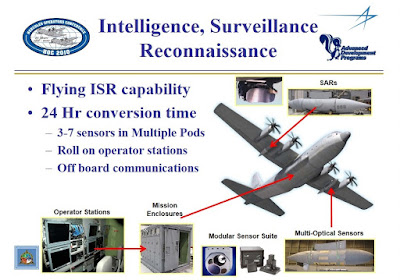01 Mei 2016
MPA ISR kit from Lockheed Martin (image : LM)
The Philippines at Forefront of New Pentagon Maritime Security Initiative
MSI funds four separate projects between the United States and the Philippines this year, costing nearly $42 million.
First, to assist Filipino military and law enforcement organizations, a maritime and joint operations center support project will “provide automatic identification systems (AIS) sensors, communications-network enhancements (software and hardware), and training to increase and strengthen the command and control (C2) relationships among the individual capabilities of the Armed Forces of the Philippines (AFP), the Philippines Coast Guard, and the Philippines National Coast Watch Center (NCWC).”
The Navy’s Space and Naval Warfare Systems Command (SPAWAR) will oversee the biggest part of this project – equipment upgrades for the three organizations to create a common operating picture, worth nearly $15 million. The Maritime Domain Awareness Common Operating Picture will bring in new hardware and software, Automatic Identification System (AIS) receivers, encryption devices, communications gear and more.
A team led by U.S. Pacific Fleet – with members from the Naval War College, U.S. 7th Fleet, Navy headquarters and more – will train and assess the Armed Forces of the Philippines on “analyzing information collected at fusion centers and preparing it for review by decision makers and international partners.” The assessment will take place in the coming months, during a bilateral Cooperation Afloat Readiness and Training (CARAT) exercise in June and a multilateral Southeast Asia Cooperation and Training (SEACAT) exercise in August. The results will help inform future investments the Pentagon may make in future MSI projects, according to the document. PACFLEET will send similar assessment teams to work with Vietnam, Malaysia and Thailand.
C-130T of the PAF (photo : Manila Bulletin)
Second in the summary of projects is a maritime intelligence, surveillance and reconnaissance (ISR) improvement project worth nearly $18 million. Naval Air Systems Command (NAVAIR) will oversee the bulk of this program, providing a Tethered Aerostat Radar System with long-range detection and monitoring capabilities to help the Philippines “detect maritime and air traffic within its coastal waters.” The aerostat will detect traffic within 90 nautical miles of its location in Puerto Princesa Palawan, Philippines, and it will feed information back to the military and law enforcement’s common operating picture.
Gregory Poling, director of the Asia Maritime Transparency Initiative at the Center for Strategic and International Studies, told USNI News that a 90 nautical mile range would not give the military any coverage of the contested portions of the Spratly Islands. Mischief Reef, for example, is about 130 nautical miles away from Palawan, he said. However, it would provide coverage of activity around entirely and mostly submerged coral reefs that are important to Filipino fisherman – an area that is not currently claimed by China, but some fear China may start trying to police the area as it gains a greater ability to project power from built-up reefs and artificial islands.
The project also includes a manned maritime patrol aircraft (MPA) palletized ISR kit to be installed on a previously purchased C-130 aircraft, as well as two roll-on/roll-off mission suite pallets, costing $8.7 million.
“This ISR suite of equipment rapidly configures standard C-130 aircraft for tactical signals intelligence, providing capabilities that identify, geo-locate, and report communications intelligence and signals of interest to air and ground-component commanders,” according to the document.
In a third program, Naval Sea Systems Command (NAVSEA) will help determine what command, control, communications, and computers (C4) may be needed for Hamilton-class high- endurance cutters the Philippines bought from the U.S. Coast Guard under the Excess Defense Articles program.
During Carter’s press conference, Philippine Defense Secretary Voltaire Gazmin said these projects will help in “attaining our goals on developing a credible defense posture, and maritime security and maritime domain awareness capabilities. As we continue to utilize foreign military financing, and access defense articles grants, we are also working on the identification of priority projects under the new maritime security initiative for fiscal year 2017, while ensuring that the estimated 42 U.S. million dollars worth of allocations for the Philippines out of the $50 million for five Southeast Asian countries for fiscal year 2016 will be utilized optimally.”
(USNI)
Langganan:
Posting Komentar (Atom)













Tidak ada komentar:
Posting Komentar